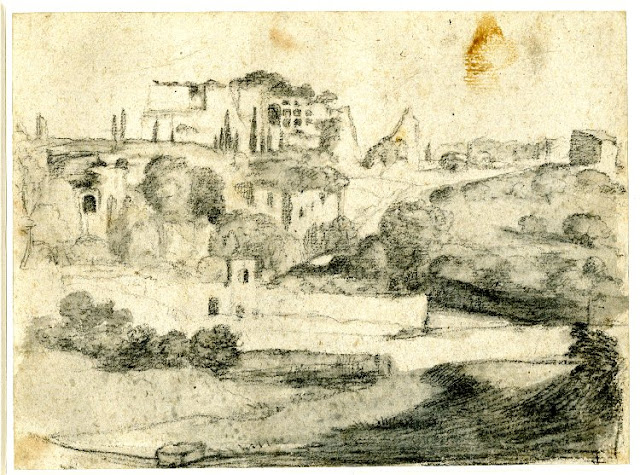 |
| Claude Lorrain Arch of Constantine ca. 1645 drawing British Museum |
"Most Holy Father,
There are many who, on bringing their feeble judgment to bear on what is written concerning the great achievements of the Romans – the feats of arms, the city of Rome and the wondrous skill shown in the opulence, ornamentation and grandeur of their buildings – have come to the conclusion that these achievements are more likely to be fables than fact. I, however, have always seen – and still do see – things differently. Because, bearing in mind the divine quality of the ancients' intellects, as revealed in the remains still to be seen among the ruins of Rome, I do not find it unreasonable to believe that much of what we consider impossible seemed, for them, exceedingly simple. With this in mind, since I have been so completely taken up by these antiquities – not only in making every effort to consider them in great detail and measure them carefully but also in assiduously reading the best authors and comparing the built works with the writings of those authors – I think that I have managed to acquire a certain understanding of the ancient way of architecture. This is something that gives me, simultaneously, enormous pleasure – from the intellectual appreciation of such an excellent matter – and extreme pain – at the sight of what you could almost call the corpse of this great, noble city, once queen of the world, so cruelly butchered."
– opening of a letter concerning the ancient monuments of Rome addressed to Pope Leo X and written about 1519 by the artist Raphael in collaboration with the humanist Baldassare Castiglione, as quoted in Palladio's Rome / translated and edited by Vaughan Hart and Peter Hicks (Yale University Press, 2006)
 |
| Claude Lorrain Interior arcade of the Colosseum ca. 1635-40 drawing British Museum |
Wash drawings by Claude Lorrain (1604 or 05-1682), one of the many 17th-century French painters based in Rome. In the group seen here, architecture is especially prominent. Claude's lifelong preference for trees and riverbanks did not prevent him from exploring the fabric of Rome itself. Cropped and muted, the same columns and arches will resurface in his moody and (in their day) very expensive paintings.
 |
| Claude Lorrain Architectural vista ca. 1640-45 drawing British Museum |
 |
| Claude Lorrain River God on the Capitoline Hill ca. 1635-40 drawing British Museum |
 |
| Claude Lorrain Tomb of Cecilia Metella ca. 1638 drawing British Museum |
 |
| Claude Lorrain Fragment of the Temple of Castor & Pollux ca. 1640-45 drawing British Museum |
 |
| Claude Lorrain Landscape with plundered ruin and wall ca. 1640-45 drawing British Museum |
 |
| Claude Lorrain Landscape with the Ponte Molle ca. 1660 drawing British Museum |
 |
| Claude Lorrain Roman wall ca. 1630 drawing British Museum |
 |
| Claude Lorrain Shrubbery and wall ca. 1640 drawing Ashmolean Museum, Oxford |
 |
| Claude Lorrain Landscape with the Tomb of Nero (so called) ca. 1640 drawing British Museum |
 |
| Claude Lorrain Ruins on the Palatine Hill ca. 1640 drawing British Museum |
 |
| Claude Lorrain Landscape with Tower ca. 1640 drawing British Museum |
 |
| Claude Lorrain Temple of Vesta ca. 1635 drawing Ashmolean Museum, Oxford |
It is interesting to see the Temple of Vesta with low-built shanties propped against the sides and masonry walls filled-in between the columns. These additions to the ancient structure were eventually removed, along with the chimney that pokes out conspicuously from the conical roof.